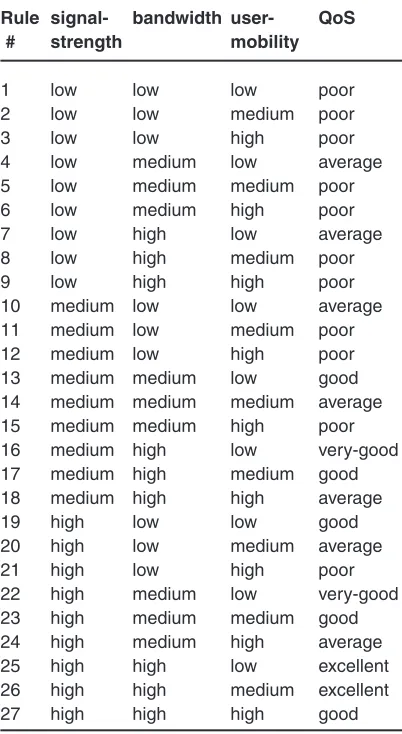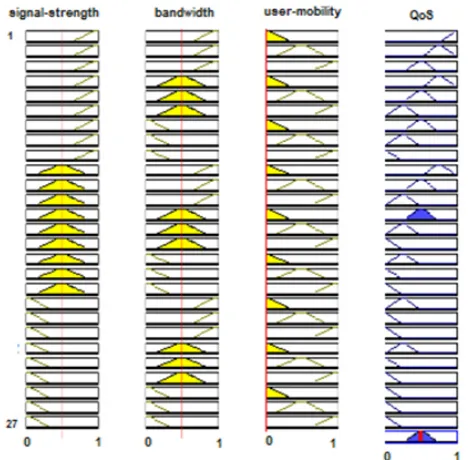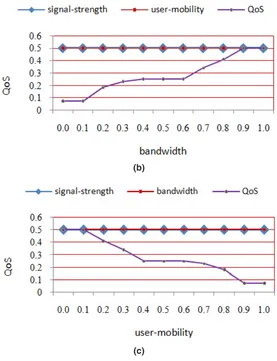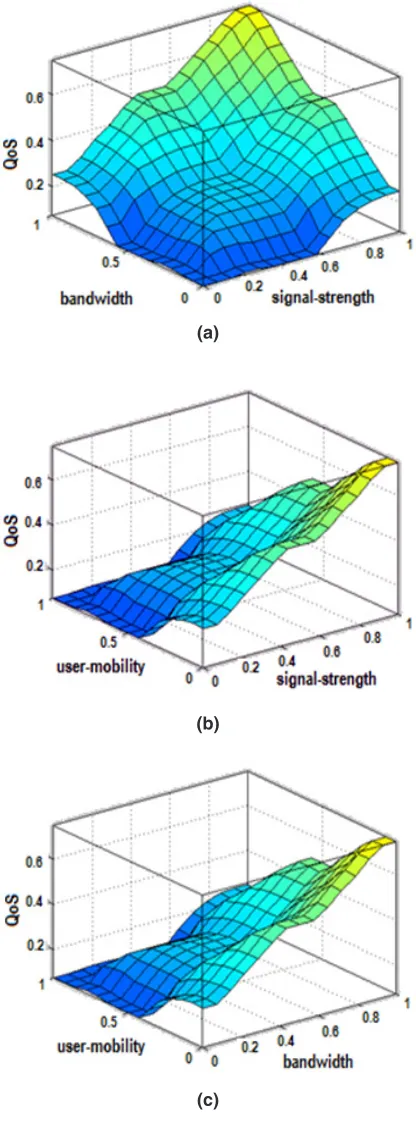Quality of Service Provisioning in Cognitive Radio Network
Dr. NISAR A. LALA
1*, ALTAF A. BALKHI
1, G. M. MIR
1and R. A. SIMNANI
21College of Agricultural Engineering and Technology, Sher-e-Kashmir University of Agricultural Sciences & Technology of Kashmir Srinagar, J&K, India.
2Department of Electronics, Gandhi Memorial College Srinagar, J&K, India.
Abstract
Cognitive radio is a future technology coined for increasing the utilization of otherwise under-utilized spectrum channels. Providing quality of service (QoS) to diverse flows as per their requirements is a very difficult job as there is no dedicated allocation of wireless channels in cognitive radio (CR) network. The paper selects few critical QoS parameters such as signal-strength, bandwidth and user-mobility that assess the influence on quality of communication between users using rule-based fuzzy inference system. The analytical results show the influence of those QoS parameters on the quality of communicating channels and open new issues in designing protocol structure for CR.
Oriental Journal of Computer Science and Technology
Journal Website: www.computerscijournal.org
Article History
Received: 16 November 2017
Accepted: 28 November 2017
Keywords
Cognitive radio, quality of service (QoS), fuzzy logic.
CONTACT Dr.NISAR A LALA lalanisar_ae@rediffmail.com College of Agricultural Engineering and Technology, Sher-e-Kashmir University of Agricultural Sciences & Technology of Kashmir Srinagar, J&K, India.
© 2017 The Author(s). Published by Techno Research Publishers
This is an Open Access article licensed under a Creative Commons Attribution-NonCommercial-ShareAlike 4.0 International License (https://creativecommons.org/licenses/by-nc-sa/4.0/ ), which permits unrestricted NonCommercial use, distribution, and reproduction in any medium, provided the original work is properly cited.
To link to this article: http://dx.doi.org/10.13005/ojcst/10.04.12
Introduction
The utilization repor t provided by Federal Communications Commission (FCC)1 spectrum
task force indicates that utilization of the allocated spectrum varies between 15% to 85%. Mitola2,3
is considered to be the pioneer of the idea of cognitive radio (CR). CR4 is a smart device having
the capability to sense the entire spectrum in order to find the idle channels and utilizing these idle channels opportunistically for communication as and when required.
The important issues of CR are as under:
Spectrum Sensing
This function finds the idle spectrum to be used for its communication and the arrival of PU on the spectrum channels presently occupied by CR.
Spectrum Management
Large chunks of idle spectrum are identified through spectrum sensing that needs to be categorized so that the best spectrum channel is selected for CR’s communication.
Spectrum Mobility
it needs to change the operating frequency instantly to minimize the interference.
Spectrum Sharing
Once transmitting channels are selected, handshaking process is initiated between communicating users first, before actual communication starts.
Providing QoS guarantees to different flows as per their requirement in CR is a very difficult job. QoS5 is
the ability of the system to provide minimum requisite service needed for satisfactory communication between users and has direct impact over CR performance. It is also defined by the degree of satisfaction of the CR users and their skill to treat different flows differently6,7. The definition of QoS
changes with types of traffic and network. The QoS is a function of multiple contradictory parameters and those are not certain and exact. Application of fuzzy logic gives more effective solution when the available information is vague and imprecise. This paper proposes to use rule based fuzzy logic for assessing the influence of three critical parameters on QoS in a cognitive radio network. At the onset, fuzzy logic found applications in control system8,9
and then in telecommunication networks10-12. Fuzzy
logic found more applications in cellular networks for admission control13 and for routing14. It was extended
to CR network for transmitting power control15 and
for optimization16. It found more applications for
controlling the spectrum access17,18 and spectrum
handoff19-21 in cognitive radio. The authors of22,23 have
analysed impact of some QoS parameters.
Materials and Methods
An algorithm, using rule-based fuzzy inference system, is proposed in this paper to analyse the impact of three critical parameters namely signal-strength, bandwidth and user-mobility on the QoS in cognitive radio. We have used Hong and Rappaport traffic model24,25 for user-mobility. The assumptions
of the model are:
• That all the users are uniformly distributed in that cell when a call is started.
• The users, starting the call, have equal probabilities of moving in any direction but afterwards move in the same direction during the call.
The handoff requests24,25 arrive into the system as
lH = (Ph (1-Bo ))/(1-Phh (1-Pf')) lo ...(1)
Ph is the probability that the communication at least need one more handoff without blocking the service request.
Phh is the probability that the on-going communication need one more handoff.
Bo is the probability of blocking of new service requests.
Pf' is the probability that handoff is not successful.
lo is the arrival rate of service requests in a cell.
Three inputs to fuzzy inference system are given as:
• input 1: signal-strength (in dBm) • input 2: bandwidth (in KHz) • input 3: user-mobility (in km/hour)
and the output of the fuzzy inference system is the quality of the communication channel in CR. Each input is characterized by three fuzzy sub-sets, such as low, medium and high, as shown in (2) defined by universe of discourse in the range[0,1]
S(signal-strength) = S(bandwidth) = S(user-mobility) = {low, medium, high} ...(2)
and QoS is characterized by five fuzzy sub-sets, such as poor, average, good, very-good and excellent, as shown in (3), defined by universe of discourse in the range[0,1]
S(QoS)={poor, average, good, very-good,
excellent} ...(3)
users. For instance, rule 2 demonstrates that if the signal-strength is low, unused bandwidth is low and user-mobility is medium, then the quality of the communicating channel is poor.
user is moving with speeds that fall under middle category. As a result, the quality of the channel is just sufficient to satisfy QoS requirements of the communicating users. Also rule 26 demonstrates that if the signal-strength is high, bandwidth is high and user-mobility is medium, then the quality of the communicating channel is excellent. The rule is translated into actual channel condition in which transmission loss of the communication channel is negligible, availability of unused bandwidth is very large and the user is moving with speeds that fall under middle category. As a result, the quality of the channel is more than sufficient so that the QoS requirement of the communicating users is easily satisfied.
The rule is translated into actual channel condition in which transmission loss of the communicating channel is very large, availability of unused bandwidth is limited and the user is moving with speeds that falls under middle category. As a result, the quality of the channel is not sufficient to satisfy QoS requirements of the communicating users. Rule 14 demonstrates that if the signal-strength is medium, bandwidth is medium and user-mobility is medium, then the quality of the communicating channel is average. The rule is translated into actual channel condition in which transmission loss of the communication channel is in middle range, availability of unused bandwidth is sufficient and the
Table a: Rules in fuzzy inference system
Rule signal- bandwidth user- QoS # strength mobility
1 low low low poor
2 low low medium poor
3 low low high poor
4 low medium low average
5 low medium medium poor
6 low medium high poor
7 low high low average
8 low high medium poor
9 low high high poor
10 medium low low average
11 medium low medium poor
12 medium low high poor
13 medium medium low good
14 medium medium medium average
15 medium medium high poor
16 medium high low very-good
17 medium high medium good
18 medium high high average
19 high low low good
20 high low medium average
21 high low high poor
22 high medium low very-good
23 high medium medium good
24 high medium high average
25 high high low excellent
26 high high medium excellent
27 high high high good
Fig.1: Membership function plots of the inputs a) signal-strength, bandwidth and user-mobility and consequent b) QoS
(a)
Fig. 2 shows the decision of fuzzy inference system for inputs such as signal strength = 0.5 (middle value), bandwidth = 0.5 (middle value), user-mobility
Fig. 2: Decision of fuzzy inference system for QoS
= 0 (stationary) and for these values the QoS comes out to be 0.5 (excellent).
Results and Discussions
The proposed algorithm is analysed for static data transfers in Matlab’s fuzzy toolbox. Figs. 3(a), 3(b) and 3(c) demonstrate the effect of signal-strength, bandwidth and user-mobility on the quality of the communication between users while keeping the other two parameters constant at middle values (=0.5).The results indicate that with increase in the signal-strength there is increase in the quality of the communication of the users, while keeping bandwidth and user-mobility constant at middle
values, as shown in Fig. 3(a).The further results indicate that with the increase in available unused bandwidth of a communication channel, there is also an increase in the quality of the communication of the users, while keeping signal-strength and user-mobility constant at middle values, as shown in Fig. 3(b). Fig. 3(c) indicates that with the increase in user-mobility i.e. when the speed of the user increases, there is decrease in the quality of the communication of the users, while keeping bandwidth and signal-strength constant at middle values.
(c) (b)
Fig. 3: Analytical results show effect of a) signal-strength on QoS b) bandwidth on QoS c) user-mobility on QoS while keeping other two parameters constant at middle values (= 0.5)
Figs. 4(a), 4(b) and 4(c) demonstrate the effect of bandwidth and signal-strength,user-mobility and signal-strength, and user-mobility and bandwidth on the quality of the communication between users while keeping the other parameter constant at middle value (=0.5). Decision surface results indicate that the equality of the communicating channels increases with increase in signal-strength and the availability of unused bandwidth, when the user is moving with constant medium speed, as shown in Fig. 4(a). The results indicate that the QoS in the communicating channel is the maximal, when the unused bandwidth and signal-strength,are at their maximal values. Decision surface results indicate that the quality of the communicating channel increases with increase in signal-strength and
(a)
(c) (b)
Fig. 4: Decision surface showing the effect of a) signal-strength and bandwidth on QoS b) user-mobility and signal- strength on QoS and c) user-user-mobility and banwidth on QoS while keeping
Conclusion
The paper proposed an algorithm using fuzzy inference system that assesses the impact of signal-strength, bandwidth and user-mobility on QoS in cognitive radio. The analysis of the proposed algorithm is being performed in Matlab’s fuzzy toolbox. The results indicate that with increase in the signal-strength and unused bandwidth, and decrease in user-mobility, there is increase in QoS of the communication between CR’s.
Aknowledgement
I would like to acknowledge and express my heartiest gratitude to my Ph.D supervisor Professor Moin-Uddin who introduced me to the very interesting subject “Cognitive Radio Technology”. I have benefitted tremendously from his vision, technical insight and valuable suggestions. Prof. Moin Uddin is a senior member, IEEE. He has more than 35 years of experience in academics and research and has served at key Positions as Director, NIT Jallandhar, Pro-ViceChancellor, Delhi Technological University .
References
1 FCC, Notice of proposed rule making and order, No. 03-222 , Dec. 2003. 2 Mitola J. Cognitive Radio: An Integrated Agent
Architecture for Software Defined Radio. Ph.D. Dissertation: KTH Royal Institute of Technology; 2000.
3 Mitola J. and Maguire G.Q. Cognitive Radio: Making Software Radios more Personal. IEEE Personal Communications,1999; 6(4): 13-8.
4 Haykin S. Cognitive Radio: Brain Empowered Wireless Communications. IEEE Journal on Selected Areas in Communications,2005;
23(2): 201-20.
5 ITU-T Recommendation. Terms and definitions related to quality of service and network performance Including dependability. E.800, 1994.
6 ETSI, Network aspects (NA). General aspects of quality of service (QoS) and network performance (NP). ETSI Technical report, ETR 003, 2nd edition, 1994.
7 Chen S. Routing Support for Providing Guaranteed End to End Quality of Service. University of Illinois at Urbana-Champaign. 8 Kickert W.J.M. and Lemke H.R. Applications
of a Fuzzy Controller in a Warm Water Plant. Automatica, 1976;12(4):301-8.
9 King P.J. and Mamdani E.H. The Application of Fuzzy Control Systems to Industrial Processes. Automatica, 1977;13(3):235-42. 10 Ghosh S., Razouqi Q., Schumacher H.J. and
Celmins A. A Survey of Recent Advances in
Fuzzy Logic in Telecommunication Networks and New Challenges. IEEE Transactions on fuzzy systems, 1998, 6(3).
11 Chemovil P., Khalfet J. and Lebourges M. A Fuzzy Control Approach for Adaptive Traffic Routing. IEEE Communications magazine, 1995; 70-76.
12 Mendel J.M. Fuzzy Logic Systems for Engineers: A tutorial. Proceeding of IEEE,1995; 83(3):345-77.
13 Ma Y., Hu X., Zhang Y., and Zhao E. A Fuzzy Call Admission Control Scheme in Cellular Multimedia Networks. International Conference on Wireless Communications, Networ king and Mobile Computing, 2005;844-7.
14 Zhang R. and Long K. A Fuzzy Routing Mechanism in Next Generation Networks. IASTED International Conference on Intelligent Systems and Control (ISC), 2002;86-91.
15 Le H-S. T. and Liang Q. An Efficient Power Control Scheme for Cognitive Radios. Proceedings of Wireless Communications & Networks Conference (WCNC), 2007; 2559-63.
16 Baldo N. and Zorzi M. Fuzzy Logic for Cross Layer Optimization in Cognitive Radio Networks. IEEE Communication Magazine,2008; 64-72.
on Communications and Electronics (ICCE),2008; 240-5.
18 Kaur P., Moin Uddin and Khosla A. Fuzzy Based Adaptive Bandwidth Allocation Scheme in Cognitive Radio Networks. International Conference on ICT and Knowledge Engineering, 2010; 41-5. 19 Giupponi L. and Perez-Neira A.I. Fuzzy
Based Spectrum Handoff in Cognitive Radio Networks. 3rd International Conference
on Cognitive Radio Oriented Wireless Networks and Communications Crown Com, 2008;1-6.
20 Lala Nisar A., Moin Uddin and Sheikh N. A.Novel Spectrum Handoffin Cognitive Radio Networks Using Fuzzy Logic. International Journal of Information Technology and computer Science, 2013; 5(11): 103-10. 21 Wanbin T. and Dong P. Spectrum Handoff in
Cognitive Radio with Fuzzy Logic Control. Journal of Electronics (China), 2010;
708-14.
22 Lala Nisar A., Moin Uddin and Sheikh N. A. Identification and Integration of QoS parameters in Cognitive Radio Networks using Fuzzy Logic. International Journal of Emerging Sciences,2013; 3(3): 279-88. 23 Lala Nisar A., Moin Uddin and Sheikh
N. A. A Novel Algorithm for Estimation of QoS in Cognitive Radio Using Fuzzy Logic.International Journal of Information Technology and Electrical Engineering,2013; 2(5):1-5.
24 Hong D. and Rappaport S. S. Traffic model and performance analysis for cellular mobile radio telephone systems with prioritized and non-prioritized handoff procedure. IEEE Transactions on Vehicular Technology, 1986; VT-35(3): 448-61.



